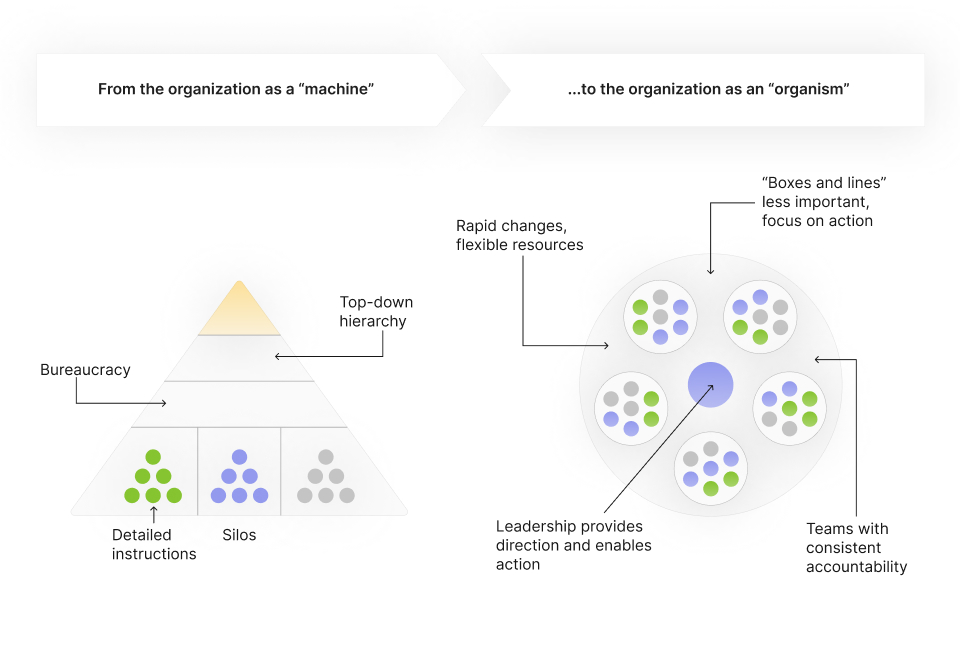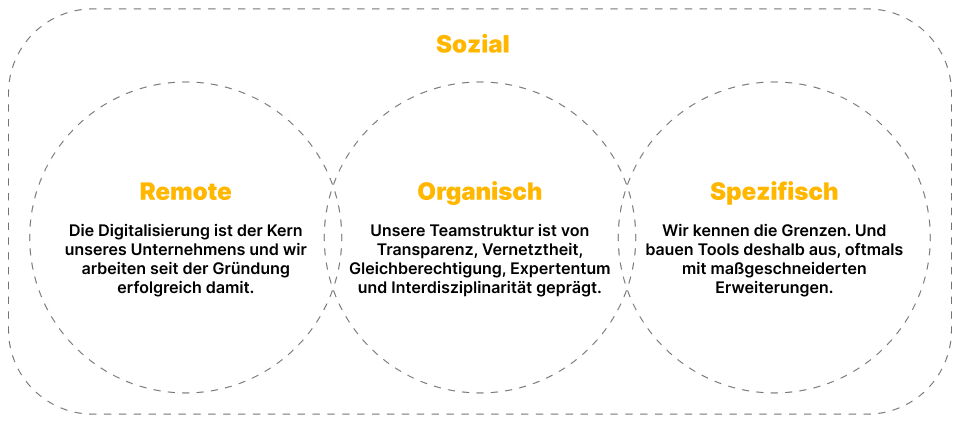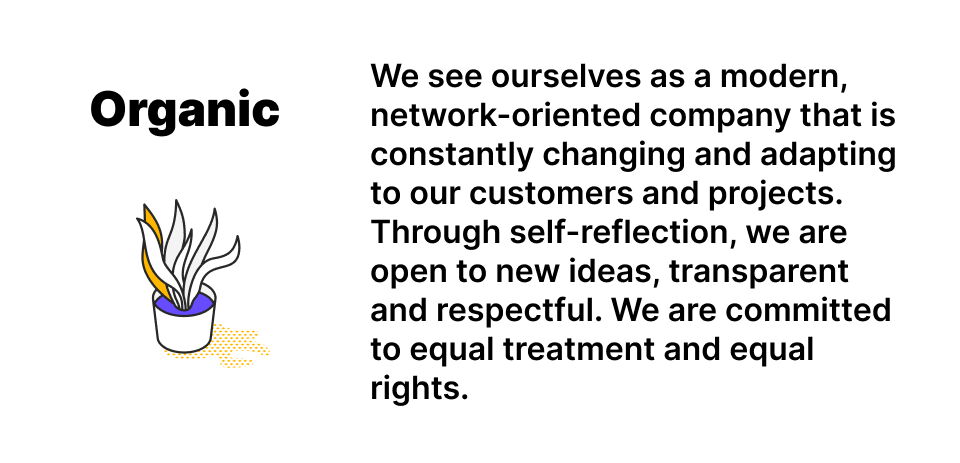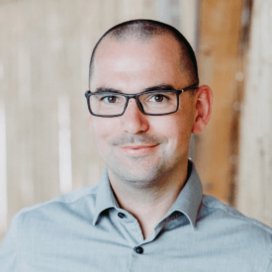ORGANIC
In this blog post, we present our penultimate value: organic.
As with each of our four value pillars, organic is central to us and sits alongside distant and specific. Let's first take a look at what it means in a business context. The term "organic company" was coined in 2014 in the book "Reinventing Organizations" (1). It reflects a very specific way of thinking about corporate culture, characterised above all by a special structure of the organisational and operational structure. The author, Frederic Laloux, wrote his book against the background of the external conditions of the global economy. According to Laloux, these conditions influence a company and determine the field of tension in which it must operate economically. Although the book was published 10 years ago, it is still relevant today.
But now to us. In the first part of this article, we will take a closer look at the terminology, why this form of organisation is important in today's dynamic world and what the characteristics of such a corporate culture are. Building on this, we will give you an insight into how we bring this value to life.
An organic company
Our world is dynamic and fast-moving, and the global economy can be simplified into two models: VUCA (2) and BANI (3).
VUCA was introduced in 1990 and stands for volatility, uncertainty, complexity and ambiguity. Both VUCA and BANI reflect characteristics of how the world around us behaves and what defines it, and it is precisely in this tension of influencing characteristics that companies find themselves. What worked and was promising yesterday may not be so tomorrow. This is why companies need to be resilient and flexible in their organisation to survive in this global situation. The required dynamism is reflected in the corporate structure - in other words, the way in which companies are organised and managed. Figure 1 illustrates this.

Figure 1: Examples of factors influencing companies in the VUCA and BANI world. Due to the prevailing economic situation (top of the figure), there is a greater impact on global markets (product launch, customer acquisition) in a shorter period of time, as seen in the right-hand side of the figure.
What does "organic" mean in the context of corporate structure?
The design of a business structure can be divided into two different aspects: the organisational structure (4) and the operational structure (4).
The former refers to how tasks and responsibilities are distributed and structured within a company. The latter refers to the processes and procedures that an organisation needs to achieve its goals. Many organisations have a pyramidal, or hierarchical, structure. These hierarchies were also a sensible and goal-oriented model for cooperation within an organisation. However, this was only true because the external factors were different from those we have today.
If we consider the organisational and operational structure as structural elements of our business, "organic" refers to a flexible, adaptable and flat business structure. Unlike traditional hierarchical models, it behaves more like a living ecosystem. Roles are flexible and can change as needed.
In terms of organisational structure, this means that fewer hierarchical levels are required and roles are not rigidly defined. This fosters a culture of collaboration and enables the business to adapt quickly to change.
In process organisation, on the other hand, this leads to flexible internal processes that can be changed as required. This means that decisions can be made more quickly and where they make the most sense. This decentralised decision-making helps the company to react quickly to change and to foster innovation. You can see the difference between the two structures in Figure 2 below.

Figure 2: Restructuring a business
Restructuring towards an organic business structure requires a culture of transparency and trust. It offers a flexible and dynamic alternative to traditional corporate structures and can help to remain competitive in today's fast-paced business world.
Why is organic one of our value pillars?
We believe that our world is as fast-moving and volatile as the VUCA and BANI models reflect. We therefore believe that for a business to be successful, it must be resilient to global economic influences. A business is resilient if it is changeable and adaptable. It needs a special culture and a special approach: an organic working model.
This allows new ideas, innovations and impulses to emerge quickly. Yet nothing is chaotic or disorganised - we still follow processes. The only difference is that we have the flexibility to change and adapt when we need to.
For all this to work, we need the right mindset and the right tools (see our white paper here). Figure 3 shows the eight principles that we 'live' at metanoy. They enable us to talk to each other on an equal footing and combine our strengths to succeed as a whole and as individual teams.

Figure 3: metanoy's values
remote, organic & specific - a perfect match?
Absolutely! Thanks to our remote value, everyone in our company is self-organised and works on their own responsibility. In addition, everyone has the greatest possible freedom to organise their own working hours.
The specific value describes the fact that we value expertise and that decisions are made by our respective experts.
Through our organic corporate structure, we combine the two values of remote and specific by integrating our principles from Figure 3 into our daily work and creating teams with consistent personal responsibility and specific expertise.
What is it like at our company?
These teams create an open and friendly culture. This means that everyone can develop, contribute ideas, explore new areas of work, train and not be forced to follow a strict set of rules.
We have an organic form of management at all levels. This means that managers are always part of a team. They work as equals and at eye level, with the same rights and responsibilities. These flat hierarchies not only promote equality within the company, but also seek to capitalise on and grow from the strengths of each individual employee. Arguments, expertise and solutions come first in every team, not the hierarchical position of the employee.
For us, working organically also means working transparently. Everyone has the opportunity to get involved in projects and to see work artefacts and project decisions. At metanoy, this is also supported by our "tooling", i.e. our digital working tools. You can read more about this in our white paper. As far as processes are concerned, we use different frameworks of agile working and take the aspects that suit us.
This open structure means that all our processes remain transparent and accountable.
An example of this is the creation of a solution concept in one of our teams. We always start with a document that is shared within the team. We do this early on in the process so that everyone has a chance to look at it and provide input. This encourages collaboration and ensures that we get better results faster. Even if it was unfamiliar at first, giving others a glimpse into the personal, unfinished state.
We encourage constant self-reflection and adapt our working methods on a cyclical basis. Above all, we have high expectations of ourselves to keep up to date. But what exactly does "keeping up to date" mean? We are constantly experimenting with new technologies and process approaches in order to be highly technology independent and to be able to recommend to our clients what will add the most value to their needs.
As you can see, at metanoy we "live" collaboration, openness and transparency. Why do we do this? Because we are convinced that it promotes our company and our culture and offers the best for our projects, customers and employees. At the same time, it allows us to be flexible and adaptable. In this way, we also serve as a direct model for our customers in the implementation of "digital transformation" (5). We show how to create the workplaces of the future.
If we had to sum up our organic value, we would put it this way:

Bibliography:
- LALOUX, Frederic. Reinventing organizations. Brussels: Nelson Parker, 2014.
- Jürgen Appelo Paper
- Hologracy Paper
- K. Gaubinger und K. Gaubinger, „VUCA-Welt als zentrale Herausforde- rung für den Mittelstand“, Hybrides Innovationsmanagement für den Mittelstand in einer VUCA-Welt: Vorgehensmodelle - Methoden - Er- folgsfaktoren - Praxisbeispiele, S. 1–27, 2021.
- / / medium . com / @cascio / facing - the - age - of - chaos - b00687b1f51d (aufgerufen am 29. 04. 2020).
- M. Altherr, „Die Organisation der Selbstorganisation“, Experten führe
Get in contact with us:

Book an appointment with our Managing Partner and Co-Founder Dr. Marek Stess or send us an email with your questions.